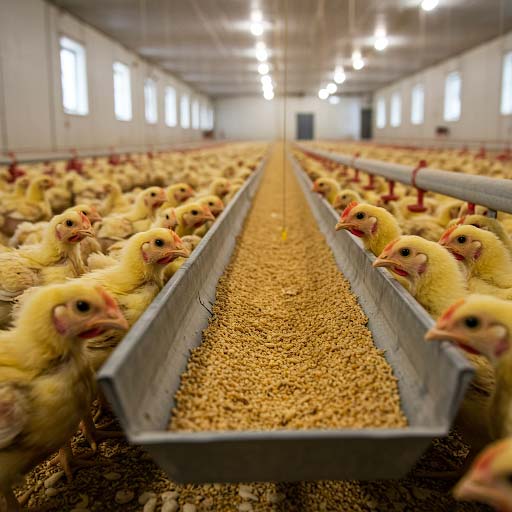The Effects of Particle Size, Feed Form, and Extrusion on Broiler Chick Performance and Digestive Tract Function
In the dynamic landscape of modern poultry production, optimizing feed quality is paramount for achieving sustainable and profitable broiler production. Feed plays a pivotal role in supporting optimal growth, enhancing feed efficiency, and ensuring the overall health and well-being of broiler chickens. At Nikdaneh, we understand that feed quality is intricately linked to various factors, including particle size, feed form (mash, crumbles, pellets), and processing methods such as extrusion.
Particle Size: A Critical Consideration
Particle size significantly influences feed intake, digestibility, and overall broiler performance.
-
Smaller particles:
- Increased digestibility: Smaller particles offer a larger surface area for enzyme action, facilitating more efficient nutrient breakdown and absorption in the digestive tract.
- Enhanced feed intake: Smaller particles can be more easily consumed by young chicks, particularly in the early stages of development, leading to increased feed intake and faster growth.
- Potential for dust: Fine particles can lead to increased dust generation, which can negatively impact air quality in the poultry house and potentially compromise respiratory health.
-
Larger particles:
- Stimulate gizzard development: Larger particles provide a physical stimulus for the development of the gizzard, an essential organ for feed grinding and nutrient extraction in birds.
- Improved feed efficiency: In some cases, larger particles can improve feed efficiency by reducing the risk of feed wastage and promoting more efficient nutrient utilization.
- Potential for feed sorting: Birds may selectively consume smaller particles, leading to nutrient imbalances and suboptimal growth.
Finding the optimal particle size distribution is crucial and requires careful consideration of factors such as bird age, feed type (starter, grower, finisher), and the inclusion of different ingredients.
Feed Form: Impact on Performance and Handling
The form of the feed, whether mash, crumbles, or pellets, can significantly influence broiler performance, handling, and overall farm management.
-
Mash:
- Easy for young chicks to consume, particularly in the early stages of development.
- Can lead to increased dust generation, which can negatively impact air quality and increase the risk of respiratory issues.
- May result in higher feed wastage due to increased spillage and dust.
-
Crumbles:
- Offer a good balance of palatability and reduced dust compared to mash.
- Suitable for older chicks and can be easily consumed by birds of various ages.
- May be more susceptible to spoilage compared to pelleted feeds.
-
Pellets:
- Improve feed efficiency by reducing feed wastage and dust generation.
- Enhance feed uniformity and improve flowability during handling and transportation.
- Improve pellet durability, minimizing breakage and reducing feed wastage during storage and delivery.
- Can improve feed intake and reduce feed sorting behavior.
Extrusion: Enhancing Feed Quality and Performance
Extrusion is a high-temperature, high-pressure process that can significantly improve feed quality and enhance broiler performance.
- Improved digestibility: Extrusion can increase the digestibility of nutrients by gelatinizing starches, improving protein availability, and inactivating anti-nutritional factors.
- Enhanced palatability: The extrusion process can improve feed palatability, encouraging feed intake and promoting better growth.
- Reduced microbial contamination: Extrusion can help to reduce microbial contamination in feed, improving feed safety and reducing the risk of disease.
- Improved pellet durability: Extrusion significantly improves pellet durability, minimizing breakage and reducing feed wastage during handling, storage, and transportation.
Nikdaneh's Commitment to Quality:
At Nikdaneh, we are committed to producing high-quality feeds that meet the specific nutritional needs of broiler chickens. Our team of expert nutritionists and feed technologists carefully consider factors such as particle size, feed form, and processing techniques to ensure that our feeds optimize broiler performance and contribute to a healthy and productive flock. We utilize advanced feed milling technologies, including state-of-the-art extrusion systems, to produce high-quality, consistent, and nutritious feeds.
Conclusion
Optimizing feed milling processes, including careful consideration of particle size, feed form, and extrusion techniques, is crucial for achieving sustainable and profitable broiler production. By utilizing advanced processing technologies and adhering to rigorous quality control standards, Nikdaneh strives to deliver high-quality, nutritious feeds that support the health, growth, and profitability of broiler flocks.
